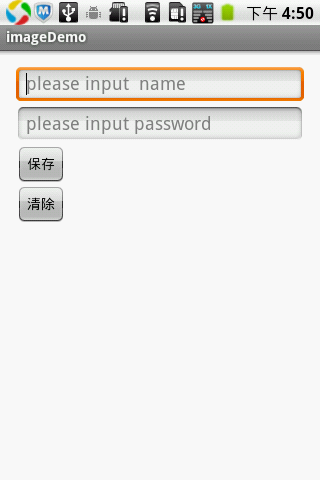android 保存 用户名和密码 设置等应用信息优化
1、传统的保存用户名,密码方式 SharedPreferences
Editor editor = shareReference.edit(); editor.putString(KEY_NAME,"username_value");
通过这样的方法,能够基本满足需求,比如有用户名,那么就Editor.putString存放就好。
但是这样的方法有一些弊端:
(1)在存放一些集合信息,存储ArrayList就不合适
(2)如果针对用户,新增加了很多熟悉,比如性别,头像等信息,那么需要一个一个的添加put和get方法,非常的繁琐。
2、通过序列化对象,将对象序列化成base64编码的文本,然后再通过SharedPreferences 保存,那么就方便很多,只需要在对象里增加get和set方法就好。
3、 序列换通用方法, 将list对象或者普通的对象序列化成字符串
package com.example.imagedemo;
import java.io.ByteArrayInputStream;
import java.io.ByteArrayOutputStream;
import java.io.IOException;
import java.io.ObjectInputStream;
import java.io.ObjectOutputStream;
import java.io.StreamCorruptedException;
import java.util.List;
import android.util.Base64;
public class SerializableUtil {
public static <E> String list2String(List<E> list) throws IOException{
//实例化一个ByteArrayOutputStream对象,用来装载压缩后的字节文件
ByteArrayOutputStream baos = new ByteArrayOutputStream();
//然后将得到的字符数据装载到ObjectOutputStream
ObjectOutputStream oos = new ObjectOutputStream(baos);
//writeObject 方法负责写入特定类的对象的状态,以便相应的readObject可以还原它
oos.writeObject(list);
//最后,用Base64.encode将字节文件转换成Base64编码,并以String形式保存
String listString = new String(Base64.encode(baos.toByteArray(),Base64.DEFAULT));
//关闭oos
oos.close();
return listString;
}
public static String obj2Str(Object obj)throws IOException
{
if(obj == null) {
return "";
}
//实例化一个ByteArrayOutputStream对象,用来装载压缩后的字节文件
ByteArrayOutputStream baos = new ByteArrayOutputStream();
//然后将得到的字符数据装载到ObjectOutputStream
ObjectOutputStream oos = new ObjectOutputStream(baos);
//writeObject 方法负责写入特定类的对象的状态,以便相应的readObject可以还原它
oos.writeObject(obj);
//最后,用Base64.encode将字节文件转换成Base64编码,并以String形式保存
String listString = new String(Base64.encode(baos.toByteArray(),Base64.DEFAULT));
//关闭oos
oos.close();
return listString;
}
//将序列化的数据还原成Object
public static Object str2Obj(String str) throws StreamCorruptedException,IOException{
byte[] mByte = Base64.decode(str.getBytes(),Base64.DEFAULT);
ByteArrayInputStream bais = new ByteArrayInputStream(mByte);
ObjectInputStream ois = new ObjectInputStream(bais);
try {
return ois.readObject();
} catch (ClassNotFoundException e) {
// TODO Auto-generated catch block
e.printStackTrace();
}
return null;
}
public static <E> List<E> string2List(String str) throws StreamCorruptedException,IOException{
byte[] mByte = Base64.decode(str.getBytes(),Base64.DEFAULT);
ByteArrayInputStream bais = new ByteArrayInputStream(mByte);
ObjectInputStream ois = new ObjectInputStream(bais);
List<E> stringList = null;
try {
stringList = (List<E>) ois.readObject();
} catch (ClassNotFoundException e) {
// TODO Auto-generated catch block
e.printStackTrace();
}
return stringList;
}
}
4、 要保存的用户对象
package com.example.imagedemo;
import java.io.Serializable;
import android.annotation.SuppressLint;
public class UserEntity implements Serializable
{
private static final long serialVersionUID = -5683263669918171030L;
private String userName;
// 原始密码
public String getUserName()
{
return userName;
}
public void setUserName(String userName)
{
this.userName = userName;
}
public String getPassword()
{
return password;
}
public void setPassword(String password)
{
this.password = password;
}
private String password;
}
5、编写SharedPreUtil ,实现对对象的读取和保存
package com.example.imagedemo;
import java.io.IOException;
import java.io.StreamCorruptedException;
import android.content.Context;
import android.content.Intent;
import android.content.SharedPreferences;
import android.content.SharedPreferences.Editor;
public class SharedPreUtil
{
// 用户名key
public final static String KEY_NAME = "KEY_NAME";
public final static String KEY_LEVEL = "KEY_LEVEL";
private static SharedPreUtil s_SharedPreUtil;
private static UserEntity s_User = null;
private SharedPreferences msp;
// 初始化,一般在应用启动之后就要初始化
public static synchronized void initSharedPreference(Context context)
{
if (s_SharedPreUtil == null)
{
s_SharedPreUtil = new SharedPreUtil(context);
}
}
/**
* 获取唯一的instance
*
* @return
*/
public static synchronized SharedPreUtil getInstance()
{
return s_SharedPreUtil;
}
public SharedPreUtil(Context context)
{
msp = context.getSharedPreferences("SharedPreUtil",
Context.MODE_PRIVATE | Context.MODE_APPEND);
}
public SharedPreferences getSharedPref()
{
return msp;
}
public synchronized void putUser(UserEntity user)
{
Editor editor = msp.edit();
String str="";
try {
str = SerializableUtil.obj2Str(user);
} catch (IOException e) {
// TODO Auto-generated catch block
e.printStackTrace();
}
editor.putString(KEY_NAME,str);
editor.commit();
s_User = user;
}
public synchronized UserEntity getUser()
{
if (s_User == null)
{
s_User = new UserEntity();
//获取序列化的数据
String str = msp.getString(SharedPreUtil.KEY_NAME, "");
try {
Object obj = SerializableUtil.str2Obj(str);
if(obj != null){
s_User = (UserEntity)obj;
}
} catch (StreamCorruptedException e) {
// TODO Auto-generated catch block
e.printStackTrace();
} catch (IOException e) {
// TODO Auto-generated catch block
e.printStackTrace();
}
}
return s_User;
}
public synchronized void DeleteUser()
{
Editor editor = msp.edit();
editor.putString(KEY_NAME,"");
editor.commit();
s_User = null;
}
}
6、 调用Activity代码
package com.example.imagedemo;
import android.app.Activity;
import android.os.Bundle;
import android.text.TextUtils;
import android.view.Menu;
import android.view.View;
import android.view.View.OnClickListener;
import android.widget.Button;
import android.widget.EditText;
public class ActivityMain extends Activity
{
EditText edit_pwd;
EditText edit_name;
Button button;
@Override
protected void onCreate(Bundle savedInstanceState)
{
super.onCreate(savedInstanceState);
setContentView(R.layout.activity_main);
SharedPreUtil.initSharedPreference(getApplicationContext());
edit_pwd = (EditText)findViewById(R.id.pwd);
edit_name = (EditText)findViewById(R.id.name);
button = (Button)findViewById(R.id.btn);
//保存到本地
button.setOnClickListener(new OnClickListener()
{
@Override
public void onClick(View v)
{
String name = edit_name.getText().toString();
String pwd = edit_pwd.getText().toString();
UserEntity user = new UserEntity();
user.setPassword(pwd);
user.setUserName(name);
//用户名,密码保存在SharedPreferences
SharedPreUtil.getInstance().putUser(user);
}
});
Button delBtn = (Button)findViewById(R.id.btn_del);
delBtn.setOnClickListener(new OnClickListener()
{
@Override
public void onClick(View v)
{
SharedPreUtil.getInstance().DeleteUser();
edit_name.setText("");
edit_pwd.setText("");
}
});
UserEntity user = SharedPreUtil.getInstance().getUser();
if(!TextUtils.isEmpty(user.getPassword()) && !TextUtils.isEmpty( user.getUserName() ) ){
edit_name.setText(user.getUserName());
edit_pwd.setText(user.getPassword());
}
}
@Override
public boolean onCreateOptionsMenu(Menu menu)
{
// Inflate the menu; this adds items to the action bar if it is present.
getMenuInflater().inflate(R.menu.activity_main, menu);
return true;
}
}
对应的布局文件
<LinearLayout xmlns:android="http://schemas.android.com/apk/res/android"
xmlns:tools="http://schemas.android.com/tools"
android:layout_width="match_parent"
android:layout_height="match_parent"
android:paddingBottom="@dimen/activity_vertical_margin"
android:paddingLeft="@dimen/activity_horizontal_margin"
android:paddingRight="@dimen/activity_horizontal_margin"
android:paddingTop="@dimen/activity_vertical_margin"
android:orientation="vertical"
tools:context=".ActivityMain" >
<EditText
android:id="@+id/name"
android:hint="please input name"
android:layout_width="fill_parent"
android:layout_height="40dip" />
<EditText
android:id="@+id/pwd"
android:layout_width="fill_parent"
android:hint="please input password"
android:layout_height="40dip" />
<Button
android:id="@+id/btn"
android:layout_width="wrap_content"
android:layout_height="40dip"
android:text="保存" >
</Button>
<Button
android:id="@+id/btn_del"
android:layout_width="wrap_content"
android:layout_height="40dip"
android:text="清除" >
</Button>
</LinearLayout>
来个截图

7、 如果我们的应用程序有不太复杂的保存需求,那么就可借助 SerializableUtil list2String 将list对象保存为文本,然后在通过文本的方式来读取,这样就不用使用数据库了,会轻量很多。